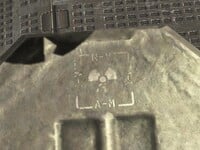Fusion coil
From Halopedia, the Halo wiki

The Fusion Core is a United Nations Space Command ground container for compressed Plasma. [1]
Operation
The Fusion Core is the "safest, most intelligent way to transport and store highly explosive compressed plasma energy". It has been confirmed from the "necessary warning signage" on the Halo 3-era cores that there is high voltage and radioactivity present within a fusion core. Formerly, there was speculation that the actual core was a highly volatile radioactive power source for UNSC ground operations, although this has been disproved by Bungie. If one Fusion Core explodes so do all nearby.
The Fusion Core may be related to the also UNSC Deuterium Fusion Core, although this hasn't been confirmed.
It is similar to the Covenant Plasma Battery, but requires less shots to be set off.
Aesthetics
Halo 2

Fusion Cores are explosive objects matte brown in color and rectangular in shape overlaid with what appears to be austere gold circuitry on the surface.
Halo 3
In Halo 3, the Fusion Core has been graphically redesigned. The actual plasma core appears to be an amber darkly-glowing cylindrical object within a metallic-gray color frame. When slightly damaged, the internal core glows a warning red. Stickers on the frame warn of radioactivity and high voltage.
Pyrotechnics
Several shots from any weapon can detonate these volatile cores, often exploding with sufficient force to severely wound or kill a nearby Sangheili or SPARTAN-II. The explosion is a bloom of pink/red superheated gas and sparks.
In multiplayer, players often may attempt to lay an ambush for a hostile near a core by rolling a Fragmentation Grenade towards the core when the enemy forays near. Alternatively, they can be pushed from above onto passing enemies, exploding on impact with the ground (sometimes a shot is needed to blow it up if from low heights) or used as an antivehicular land mine (sometimes with more than one Fusion Core) at vehicle choke points.
Appearances
Halo 2
Fusion Cores can be found on six Halo 2 multiplayer maps: Foundation, Headlong, Ivory Tower, Tombstone , Zanzibar and Waterworks, although they are not seen in the campaign.
Halo 3
Fusion Cores were spotted in the Halo 3 Beta in the multiplayer maps High Ground and Valhalla, and appear in further multiplayer maps in the actual game, including their campaign debut in the level Crow's Nest.
However, Fusion Cores feature prominently in the Forge multiplayer map editor, where players can place a large amount of cores on any location in a map and detonate them. In a Bungie Weekly Update, a Halo 3 tester was mentioned to be able to place a "ridiculous" number of exploding cores in an Elephant vehicle, and set the core respawn timer so that as a core exploded, it would respawn and detonate again almost instantaneously, making the vehicle "[flip] around at incredible speeds and [tumble] all over the map, releasing exploding cores and the occasional vehicle like some kind of satanic piñata."[2]
In Halo 3 Fusion Coils are present in most Earth based multiplayer maps and several other world maps. They are also located on the Halo 3 campaign levels, Crow's Nest, The Storm and Floodgate.
Elephant Flipping
- Main article: Flying Elephant
Often players go onto forge in Sandtrap and flip an Elephant. They do this by selling everything on the map except one single Elephant. They then purhase and place as many fusion coils as possible in, under, or around it. Then make the respawn time instant and activate the coils. The Elephant flies all around Sandtrap and the coils (and everything else) constantly fly out.
